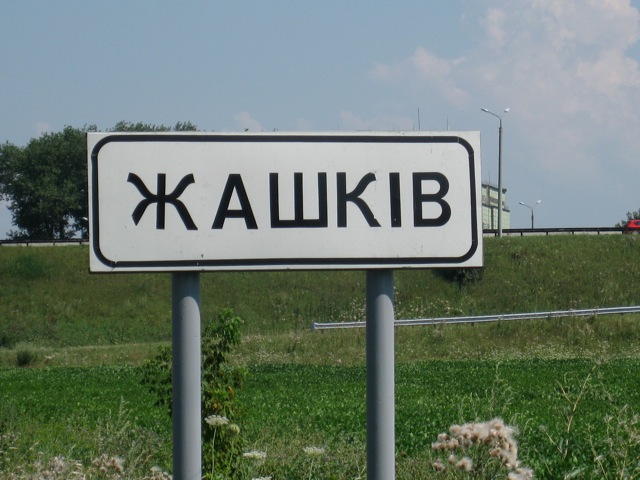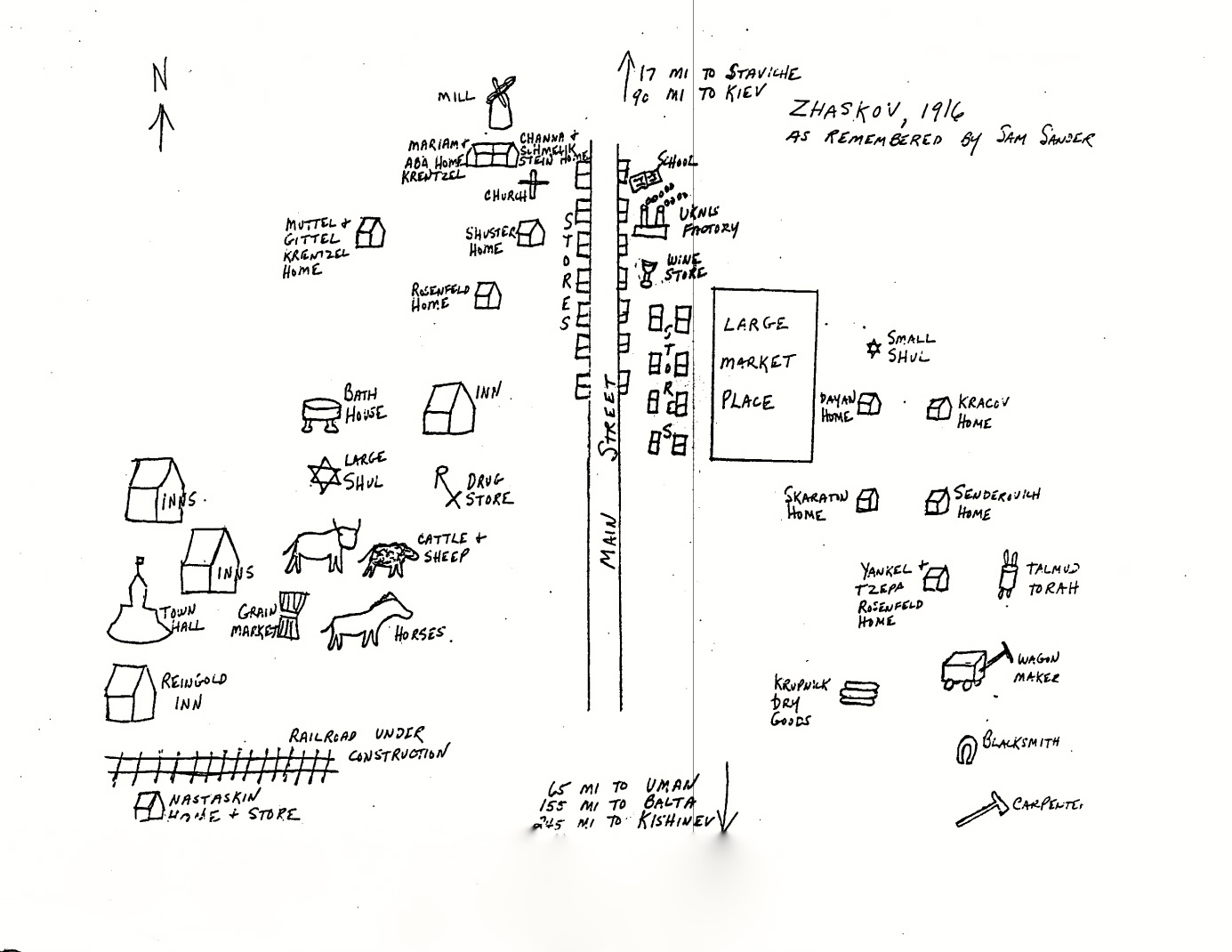
In gathering information about my uncles, aunts, grandparents and
great-grandparents, I came into contact with others who shared a common
heritage of Zashkov(Yid)(Zhaskiv,Ukr., Zhaskov (Rus) and learned that
no one had created a kihilia web site for the town.
With the memories
of those of my relatives who actually lived in Zashkov before
emigrating to the United States and those who died without emigrating,
I have created this web site as a small memorial to the times and
culture that no longer exists and which may very readily be forgotten
in a generation or two. I want to thank those with a shared
and continuing community of interest in Zashkov ( and with the computer
skills help of my son) who with me have created this web site which in
many ways is a continuing work in progress.
Zashkov lives as long as we
will it to.
History of Zashkov by Jerome A. Hoffman
As a child, I remember my grandparents being active members of what I
thought was a burial society called Zashkover Untershtuzing Verein of
Philadelphia. These memories became more vivid as I attended
funerals of them, and later of my parents generation at Mt. Sharon
Cemetery in suburban Philadelphia in the Zashkover owned
sections. I also reveled in tales by my grandfather (actually
Zayda to me) Jacob (Yankel) Bass (Bas) about parts of his life in
Russia and why he left it in 1909. That together with my more
recent research has enabled me to put together the following history of
Zashkov.
Today Zhashkiv, Ukraine is a small town in Cherkasy (province),
Ukraine. Its population is in the 15,000 range and is known for
its horses. It has at best a handful of Jews. At the turn
of the 19th century, e.g., 1900, it had a smaller population population
but there were 2445 Jews in it engaging in a variety of occupations
including sugar manufacturing (from beets), textiles, inn-keeping,
religious, peddling and cobbling to name a few. By 1913 its total
population was 5501 and its remaining Jews spread across many
occupations, including perhaps one on the ruling town council.(This is
based on a photo of a document taken by Hana Hoffman, whose grand
parents came from Zashkov showing businesses and names in that year.
The photo and translation by Nathan Gabriel can be found on the Bila
Tarascha kihilia website) It was and is located about 37 miles
south of Bila Tarascha, 35 miles north of Uman, 84 miles south by
southwest of Kiev (Kyyiv), and 28 miles southwest of Tarascha. In
1900 and until late in the 20th century, it was in the Tarascha
district and in the province (gubernia) of Kiev. At that time and
at the present there was a railway station, Zhashkiv which most likely
was established in response to the sugar production factories and horse
farming in the area. The following map, drawn by Sam Sandler as he recalled Zhaskov in 1916, illustrates the area.

Jews have been in what is now the Ukraine for over a 1000 years,
including parts of the Khazar Empire whose rulers purportedly converted
to Judaism between the 8th-10th centuries which at one point included
Kiev. The continued to migrate into the area from Poland, especially
under the governance of the Polish/Lithuanian empire. The
town of Zashkov is recorded as the site of a major battle in the
Russo-Polish War of 1654-1667 in which the Russians ultimately defeated
the Poles and annexed the Ukraine. I can find no reference to
Jews in the town at that time nor in the devastation of the of the
Cmielnicki massacres of Jews and Poles in 1648 but there is no reason
to believe they were unaffected. Similarly, there were continuing
pogroms in Ukraine with particularly deadly ones in the late 19th
century, one in 1905 period that I know affected Zashkov based on what
my grandfather told me because one of his brothers was killed in
it as a member of the Shomrim defending the town. There
were also deadly pogroms in the 1918-19 period, one of which in the
Summer of 1919 led by Ottoman Kazak resulted in the death of the
town's Rabbi as well as Hersh Reingold, owner of the Reingold Inn shown
on the hand-drawn map as well as Moshe Skaratin, one of the
shomrim. It that large numbers of the Jews to evacuate the town
for safer locations. In the 1920's the Ukraine suffered
devastating famine and Jews like others died. I know from
personal knowledge that my great-grandmother Tovia Bass died during the
famine in the arms of her niece, Gitel Bass in Zashkov.
During the period 1875-1930, millions of Jews emigrated from Ukraine to
the United States, Argentina, South Africa, UK and Israel (then
part of the Ottoman Empire and subsequently the Palestine
Mandate. This included many from Zashkov (I have been able to
track close to a 1000 emigrants and I am sure there are many
more). The emigration is stark proof that life was difficult for
Jews under the Russian and Soviet Empires. The Tsar's negative
policy towards Jews did not overlook Zashkov. My grandfather told
me that the main reason he emigrated was because the not being the
oldest son, he was subject to the compulsory draft and had to hide in
the out-house of one of the Zashkov churches when they came for him (at
the time he was married and had at least 4 sons). Although as seen in
some of the vignettes written by Zashovites in the United States which
are part of this posting, there was a vibrant Jewish life in existence,
people got married, couples had children etc. etc. Nonetheless, the
lucky ones were those who were successful in emigrating because the
remainder who either chose to stay or were not permitted to emigrate as
the world including the U.S. closed its borders to immigrants from
Eastern Europe, were essentially wiped out by the Nazis.
According to the account of a recent visitor, there are at best only a
handful of Jews in Zhashkiv.
Zashkov was not spared the Holocaust with the resultant extermination
of the Jewish community there. As noted above, Zashkov, now known
as Zhashkiv is almost a Jewless town today, but still has its railroad
station, its horse breeding industry and its Jewish memories including
an old Jewish cemetery with a few gravestones still remaining (see
photos taken by grandchildren and great-grandchildren of those who
emigrated posted on this web site. While the Jews are essentially
gone, there is a small Jewish museum with a few Judaica relics, echoing
the museums established by the Nazis in Czechoslovakia as a monument to
exterminated races.
Although Jewish Zashkov essentially no longer exists, those that
emigrated to the United States set up active Verein(fraternal)
societies in New York City and Philadelphia. Particularly in the
1920's-1950's these were vibrant associations that not only provided
for burials, but also a social network that facilitated marriages,
business relationships, and assistance to those who were still trying
to emigrate. Selections from publications of those societies are part
of this posting. Those that emigrated to New Haven and Baltimore
kept in touch with their "landsmann" via these societies.
Many of those who emigrated from Zashkov became well known in later
years. For example Moshe Dayan, son of Shmuel Dayan. Samuel Noah
Kramer (born Zashkov 1897), the renown Ancient Near East Professor and
writer ( "History Begins at Sumer"), and of course, my own uncle Benny
Bass (born Zashkov 1903) who in the 1920's and 1930's went on to hold
two World Boxing Titles.
Other Sources of Zashkov History
Special Collections Research Center, Temple University Libraries-
Kranzel donation Traditions in Transition: Jew Culture in Philadelphia
Exhibition by Balch Inst., Gail F. Stern Landsmanshaftn Collection,
n.d. 1899-1971,1991 American Jewish Historical Society
Smithsonian Inst. Archives Coll. Acc. 05-014 (Reingold Documents)




